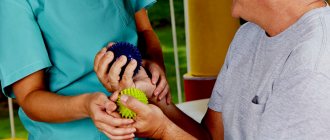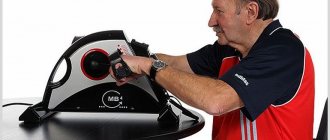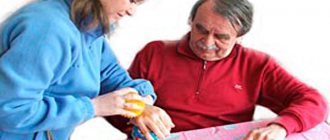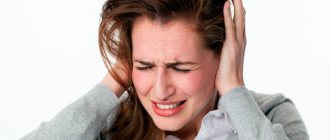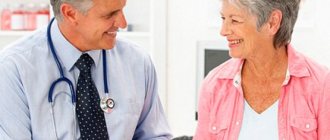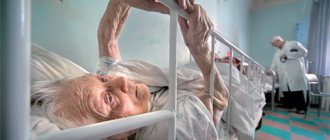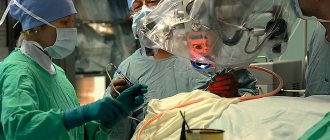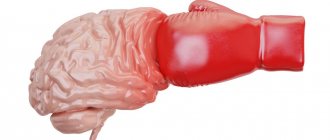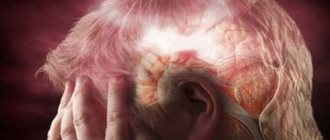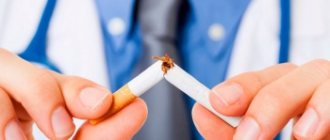Motor dysfunction
Paralysis of the lower extremities in ischemic stroke is observed in 80% of cases.
Also, the legs can be paralyzed due to hemorrhagic hemorrhage, but most often it disrupts the functioning of only one leg. Such consequences are explained by the fact that after a failure of blood circulation, the areas of the brain that respond to movement are left without power. How violations may manifest themselves:
- The gait becomes very unsteady, the person may sway to the sides;
- The leg does not straighten or bend;
- When moving, the injured leg describes a semicircle, reminiscent of turning a compass;
- The person stands on his toes and finds it difficult to stand on his entire foot.
Restoring contact between the brain and muscles, learning to walk, and regaining the ability to control the legs are the main tasks for the rehabilitation period. This may require a lot of time and patience. In most cases, it takes 3 to 4 months to restore motor function. Sometimes this period can last even longer, because... everything is complicated by the patient’s fear of not achieving results, lack of motivation and decreased cognitive functions.
A stroke is a very strong blow not only to the body, but also to the psyche. Therefore, the support of loved ones is very important for the patient. Their task will be to provide comfortable conditions for the rehabilitation of the victim. It is important to try to rid him of fear, convince him that there is no need to be afraid, constantly communicate with him and help him in everything.
Dealing with the consequences
A stroke is characterized by the appearance of typical neurological disorders. The most common symptoms are complete paralysis, partial paralysis, loss of speech and memory, as well as hearing and vision impairment.
It is not possible to avoid the consequences of a stroke. The only thing. what can be done is to create acceptable conditions for partial or complete resuscitation.
The following conditions should be highlighted:
timely hospitalization;
Statistics say that partial resuscitation is possible only in 70 percent of cases.
Terms of rehabilitation
Recovering from a stroke requires significant effort and patience from both the patient and those around him. The rehabilitation period can last for a long period.
Statistics show that only a small proportion of patients are able to completely resuscitate brain activity. Much more often, patients recover partially. The duration of the rehabilitation period depends on the type and extent of brain damage.
Contraindications for the recovery period
If the patient’s health condition is determined to be very severe, then rehabilitation measures are not prescribed. Rehabilitation is impossible if:
- the patient is in a comatose state;
- presence of mental problems;
- aggressive behavior of the patient;
- relapses;
- the presence of a complex, progressive form of diabetes mellitus;
- presence of seizures;
- presence of tuberculosis;
- the presence of cancerous tumors.
Classes with a rehabilitologist and independently
Restoring motor function is painstaking work, which is very important to begin as early as possible.
All exercises must be selected by a specialist and carried out strictly under his supervision. Only a rehabilitation doctor can choose the necessary training program, its duration and effectiveness.
After discharge from the hospital, you must independently continue to perform the exercises and activities prescribed by the doctor.
It is impossible to restore motor function abruptly. Everything should happen gradually, the patient should be monitored in order to receive timely help if necessary. But even with the right approach to rehabilitation, achieving a positive result can be extremely difficult. It is very important to follow a number of simple rules:
- Warming up the muscles. Before any exercise, you should warm up your muscles so that they work better and are not damaged.
- Help from loved ones. During any physical activity, the patient should have close people nearby who will help if he falls or gets injured.
- Safe conditions. You should begin trying to walk only in a room where the patient will not be injured by falling and will not trip over any things.
- Go outside. You can only move your walking training outside in good weather. If it is hot, cold or very windy, the patient will become ill.
- The right shoes. Feet should be dressed in shoes that are high and close to the skin, but they should be light, comfortable and easy to put on.
It is equally important to dose the load. You should not immediately go on a long walk without good preparation. It is recommended to always start small. At the same time, you need to let your body regain its strength, and not start training immediately after leaving the hospital.
Almost everyone after a stroke sways in different directions while walking. To get rid of this problem, you need to strengthen the muscles of the lower extremities. This can be partially achieved with the help of simple gymnastics, but the main recovery will occur in the process of re-learning to walk. While the person is unstable, a special support should be used. 3 options are suitable:
- Cane. A familiar attribute for older people can help anyone who has suffered a stroke. Using a cane can make walking training safer and more effective. The advantage of this option is its low cost and simplicity.
- Walkers. A special vehicle will create support on both sides at once. There are several types of walkers, which allows you to choose the most suitable option. The main advantage of this method is increased safety for the patient.
- Crutches. This is a very safe option, but it is the least effective. It will not be possible to quickly restore motor function with crutches, because... their use interferes with walking training.
You can try to train even without support, but then physical support from other people will be very important. If it is not there, the patient will fall, which can not only cause pain, but also set the result back several stages, and a complete loss of motivation will be possible.
Dealing with the consequences
A stroke is characterized by the appearance of typical neurological disorders. The most common symptoms are complete paralysis, partial paralysis, loss of speech and memory, as well as hearing and vision impairment.
It is not possible to avoid the consequences of a stroke. The only thing. what can be done is to create acceptable conditions for partial or complete resuscitation.
The following conditions should be highlighted:
- timely diagnosis;
- timely hospitalization;
- rehabilitation after a stroke.
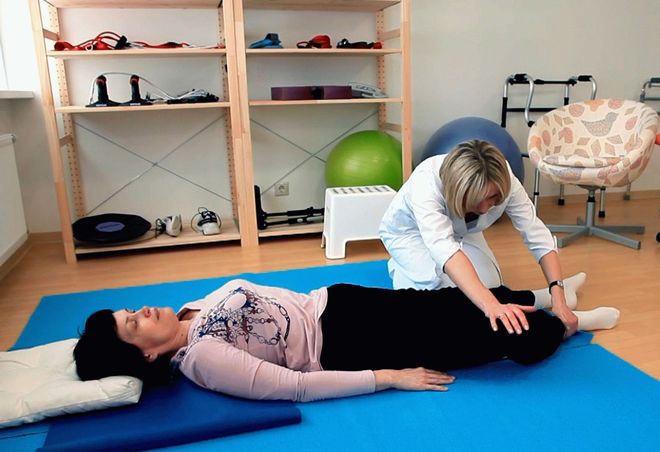
Statistics say that partial resuscitation is possible only in 70 percent of cases.
Terms of rehabilitation
Recovering from a stroke requires significant effort and patience from both the patient and those around him. The rehabilitation period can last for a long period.
Statistics show that only a small proportion of patients are able to completely resuscitate brain activity. Much more often, patients recover partially.
If the patient’s health condition is determined to be very severe, then rehabilitation measures are not prescribed. Rehabilitation is impossible if:
- the patient is in a comatose state;
- presence of mental problems;
- aggressive behavior of the patient;
- relapses;
- the presence of a complex, progressive form of diabetes mellitus;
- presence of seizures;
- presence of tuberculosis;
- the presence of cancerous tumors.
Passive gymnastics
Walking restoration should begin with passive gymnastics. It is carried out with the help of a rehabilitation doctor or a loved one who is familiar with this technique. Movements must be performed in all joints of the legs. The classes are very simple: the patient lies down, and the rehabilitator takes him by the limbs and performs certain movements.
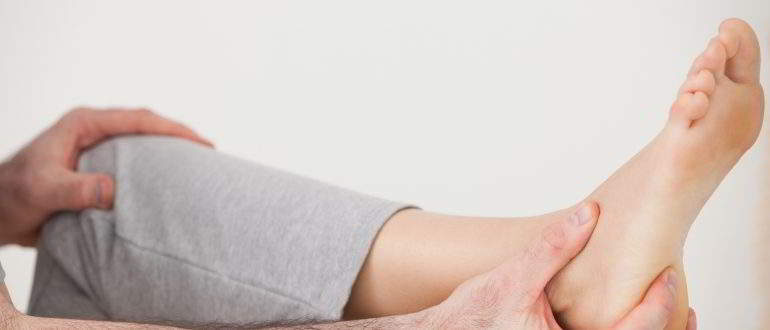
Training may include:
- Circular rotations in the joints 5 times each. After completion, you should repeat them in the opposite direction.
- Stretching all joints. You need to pull out all the joints one by one, and then press them back with a slight movement. Repeats several times.
- Flexion and extension of each joint. You need to bend and straighten each of them at least 7 times.
These exercises are repeated for a short period of time - about a week. They can be supplemented with an unusual method. It consists of hanging a special loop over the patient’s bed, into which he must insert his leg, hooking his foot. The rehabilitation therapist will slowly rock the patient's leg. When a person begins to recover motor functions, he can swing the limb independently.
Gradually, the recovery of the leg after a stroke should be transferred from passive to active gymnastics, but some kind of preparation will be required. The patient will need to show willpower and mentally try to achieve mobility of the limbs. This goal can be achieved using 2 methods:
- Mental sending of impulses. The patient must imagine the movement with the paralyzed leg, then reproduce it with the healthy one if only one is injured, and then try to mentally transfer the resulting sensation to the first limb. Such impulses must be sent repeatedly.
- Motivation from the outside. A rehabilitation therapist or a loved one should constantly talk with the patient, trying to motivate him to active movements. You need to ask him to help move his limbs, convince him that everything will work out soon, and also praise him for any successes achieved.
When he is able to perform the movements, he should immediately move on to active gymnastics, which will lead to a speedy recovery and learning to walk properly.
general information
Stroke usually occurs in 3 forms:
- Favorable.
- Intermittent.
- Progressive.
In the first case, restoration of consciousness occurs after a few minutes or hours. In the second and third cases, restoration of consciousness occurs only on the fourth day.
If the prognosis after treatment of the first form is quite favorable, then soon the person will be able to revive impaired brain functions.
In the second case, the consequences of a stroke in men and women are quite sad. Possible risk of relapse. A person may also develop cardiac and pulmonary pathologies. In the third case, death often occurs.
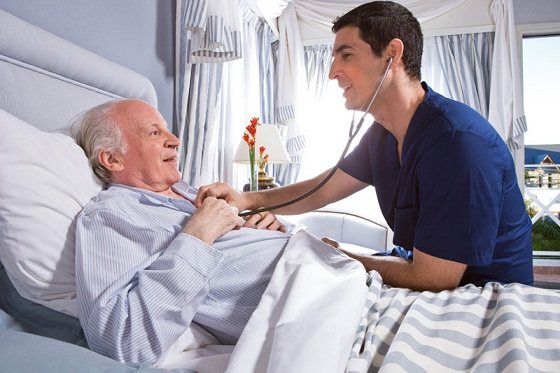
Active gymnastics
The first active exercises should be performed in a lying position. They help restore all basic limb movement skills, and at the same time, gymnastics will improve blood circulation. It is important to monitor the load so as not to overexert a weakened body. If it becomes difficult for the patient, then you need to stop all training and give him a rest.
You can do quite a few different exercises while lying down. A rehabilitator or a loved one must ensure that all movements are correct and the muscles are fully functional. The gymnastic complex for bedridden patients includes the following exercise options:
- The direction of the feet is outward and inward. This should be done with your legs bent at the knees, and the soles of your feet should be pressed against the surface of the bed.
- Knee bends. When bending, the foot should move along the bed. Can be supplemented with similar hand movements. First you should train your right limbs, and only then your left ones.
- Heel movement. You need to lie straight, with the foot of one leg running along the front of the shin of the other. Then repeat for the second limb.
- Reverse leg curls. The person lies on his stomach and begins to slowly bend his legs at the knee joint, repeating the movement several times.
- Lifting and spreading the legs. First you need to raise your legs up, slowly spread them in different directions, and then return them to the starting position.
- Raising the pelvis. You need to bend your knees and then slowly lift your pelvis up. This should not be done too hard so as not to injure the joints and spine. Movements should be smooth and careful.
- Side leg raise. The patient lies on his side and begins to slowly raise and lower his upper leg. After several repetitions, you should do the same on the other side.
- Swinging legs. You should bend your knees, resting your feet on the bed. The goal is to throw one leg over the other. The exercise must be performed alternately for both legs. If it seems difficult, then the leg can be thrown only to the knee, fixing it on it and slowly moving it to the side.
- Turning over to the other side. It is done by bending the knee joints, throwing the bent legs to the side and independently turning the body in a given direction.
- Pedaling. The well-known “bicycle” exercise requires lifting your legs bent at the knees and slowly rotating them in such a way as if a person is pedaling a bicycle. It is important not to overdo it, because... Rapid movements can cause damage to weak joints.
When the patient can perform these actions easily enough, you need to move on to the next stage. It involves trying to get back on your feet so you can begin walking exercises after a stroke.
Getting up
When the patient learns to sit without any help, the rehabilitation process can be considered successful. The main task then becomes the development of this skill and long-term retention of the position. Therefore, it is necessary to teach him to remain sitting for a long time. To do this, you need to help the person sit down by lifting him by the arms.
If a person can already sit, then it is worth moving on to full-fledged exercises that will strengthen this skill. All of them are performed at home. The most effective of them:
- Head rotation. It is required to perform circular movements with the head, capturing several cervical vertebrae (up to 7) with it. Additionally, you should tilt it forward. The exercise is repeated up to 10 times.
- Holding a position. You need to sit on the bed and hold on to a hard, reliable surface with your hands, carefully arching your back. The exercise only takes a few seconds, but requires 10-15 repetitions.
- Lifting your feet off the floor. The patient should sit on the bed and raise his feet 40 cm so that they do not touch the floor surface. You need to hold this position for about 10 seconds. Repeat the exercise 10-20 times.
Additionally, you can alternately pull your legs towards your chest while lying on your back to prepare your joints for future stress. After completing all the therapeutic exercises, you should try to learn how to get up. It will be very difficult, but you will be able to achieve results if you try hard and believe in yourself. It is attempts to get up that are the main method of restoring walking after a stroke. There are 2 training options:
- Lifting. With the help of a rehabilitation therapist, the patient should rise slightly while remaining on the bed. Gradually the level of lift should be increased.
- Movements on the bed. The patient needs to sit on the edge of the bed, and then slowly move from the top to the bottom, moving his legs along the floor.
When you manage to stand up fully, you can move on to walking. The last stage will be the most difficult, so loved ones should show increased attention and care towards the sick person.
Walking
You should start walking very carefully. Almost everyone's first attempts to start walking end in falling to the floor. Therefore, the patient must first be physically supported to avoid accidental injury. It is important to consider that learning to walk will be very difficult and this stage can take a huge amount of time.
The rehabilitation specialist must ensure that the patient walks correctly. If you don’t do this, it will be difficult to relearn, and the effectiveness of all classes will drop significantly. The following points need to be ensured:
- The legs rest on the heel. In most cases, people stand on their toes after a stroke, which should be avoided at all costs.
- The feet move straight forward. Many patients move their legs, describing a semicircle with their feet, which should not happen during the learning process.
- The knee bends before placing the foot on the heel. If the patient leaves his leg straight, then you should pay attention to this and correct his mistake.
You need to think about how to restore your leg after a stroke only after remembering the listed rules. Once the patient is familiar with them, you can move on to the first exercises to regain the ability to walk fully. Among them:
- Trampling. You need to slowly shift your weight from one leg to the other, and then back. You need to repeat such movements many times in a row. At first, the feet should lift off the floor only slightly, but later they should be lifted completely.
- Rifles. You should stand up straight, keeping your feet together, and begin to roll your weight from your heels to your toes, and then back. Such rolling should be performed within a few minutes.
- Stepping over. Any object should be placed in front of the patient. A pen or pencil is a good place to start, but larger items should be added later. Its task is that the placed object must be stepped over.
If you can perform the exercises without any problems, you should switch to normal walking. First you need to learn to walk around the apartment. All steps should be small and careful, and you should limit your speed.
A little later you can move outside. The patient must be accompanied by another person who can help if necessary. First, you need to take short walks, walk to the store or the nearest park, try to walk along the drawn line and lift up alternately with both feet on the curb. Later, you can move on to training by walking up the stairs, and it is best to walk along them sideways.
To choose the right program for restoring walking, you need to be able to distinguish the signs of a musculoskeletal disorder:
- unsteadiness of gait;
- inability to fully bend or straighten the limbs;
- impaired coordination of movements;
- decreased sensitivity;
- walking on toes;
- inability to walk quickly.
As mentioned above, treatment with physical exercises must begin from the beginning of the second month.
How to start
There are 4 main stages that precede independent walking.
Stage 1 – passive exercises. These are the very first exercises in a lying position - fixing the limbs in different positions.
All passive exercises are conducted by a rehabilitation specialist. First, he independently warms up the limbs, then connects the patient’s muscle memory. To do this, exercises are performed first with a healthy leg or arm (as a rule, one hemisphere suffers during a stroke), and after the movement they are mentally transferred to the affected limb.
Passive exercises include:
- flexion and extension of the knee joints;
- rotation, flexion and extension of the feet;
- abduction, flexion and extension of the hip joints.
Stage 2 – active exercise and sitting training. After a set of passive exercises, the patient has more strength for new skills. At this stage, you can include the following exercises:
- throwing legs over one another;
- bending and straightening the legs at the knees while lying on the stomach;
- "bike";
- turning the feet from a lying position with bent knees;
- move the heel of the foot along the shin of the other leg;
- lifting with legs moving to the sides;
- lifting the pelvis from a lying position with bent knees;
- raising legs while lying on your side;
- turning to one side.
The last exercise is necessary for further correct sitting. In order to sit the patient down, you need to release your legs to the floor and spread them wider, push off the bed with your healthy hand and take a sitting position.
Stage 3 – learning to get up and stand. When training the process of standing up, the following exercises are used:
- lifting the body while lying on the bed;
- moving along the bed.
After consolidating the exercises and gaining knowledge, the patient can try to stand up.
Before the patient himself can take the first steps, it is necessary to do some steps:
- stomping on the spot without lifting your feet off the floor, raising your feet a little later;
- rolling the foot from heel to toe and vice versa;
- stepping over an obstacle - at first it should be something low, with the development of skill the obstacle is increased;
- moving the foot back with support on the toe.
Stage 4 – restoration of the walking process. At this stage, the patient, with the help of a doctor or special assistant, tries to take the first steps. During this period, it is advisable to use special walking devices, for example, three- or four-legged walkers.
Walkers
Walkers are quite heavy and at first will serve as a great support for the victim.
After the patient learns to stand confidently with a walker, then with their help he will be able to move his legs, thereby stepping forward.
It is worth noting that it is necessary to select and adjust the walker correctly so that the rehabilitation process proceeds as quickly and comfortably as possible.
There are different types of walkers on the market, so you can freely choose which one is suitable for a particular patient.
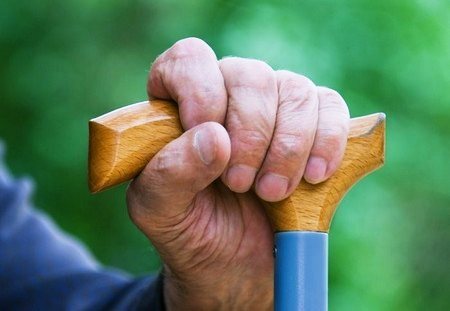
It is worth paying attention to the universal design. These walkers can work as fixed, stationary and walking.
Quick results
For the fastest possible recovery effect, it is necessary to constantly consolidate all the skills acquired during this period with additional exercises and warm-ups. The recommended time for daily exercise is 30 minutes 2 times a day.
If the patient feels strength or, conversely, weakness, then this time must be adjusted depending on the situation.
If a person already knows how to stand up on his own and take steps with support, it is necessary to gradually complicate the activities, for example, by walking on sand or grass. After consolidating these exercises, you need to move on to more complex ones - climbing to small elevations, gradually bringing them to climbing stairs.
To make exercise more comfortable and achieve maximum effect, you must wear special orthopedic shoes that secure the foot.
It is also very important to teach the patient to be independent. He can and should be helped in everything, but not done for him.
The main rule for a quick and effective rehabilitation process is constant exercise with a gradual increase in loads and following all recommendations prescribed by the attending physician.
After the patient has been able to sit down, stand up and take the first steps independently, it is necessary to use special fixing devices in the exercises to help the correct formation of gait. These include:
- holders for fixing the foot - for proper distribution of weight on the foot and avoiding walking on the toes;
- clamps - knee pads - to hold the knee joint in a vertical position.
One of the effective methods for developing the correct gait is to draw footprints for the patient to walk. This technique is common in rehabilitation centers.
You can also use special treadmills to develop your gait and speed up the recovery process. This device has special extended handrails, the lowest possible speed and an emergency braking button.
If possible, it is recommended to include Nordic walking in your list of activities.
How to learn to walk after a stroke
Main enemies
2. Pain
Main assistants
Stroke of any type is a complex disease that affects major body functions, including speech, musculoskeletal system, memory and heart function.
Finding out what not to do after a stroke will be of interest to patients who have been diagnosed with this and their relatives who are planning their care schedule.
The speed of recovery depends on the success of rehabilitation and compliance with the doctor’s recommendations. Many patients manage to return to normal life even after severe forms of stroke with additional pathologies.
It is possible to restore the vital functions of the body with serious effort, but this process can take years. According to statistics, patients who have suffered a stroke recover only partially, since this pathology affects the brain.
Important! The initial stage of treatment takes place in a hospital setting, where the patient is brought out of unconsciousness and hemodynamic parameters are normalized.
An additional healing course in a sanatorium or specialized center, where suitable conditions for full recovery are created, has a good effect.
Organizing recovery at home after discharge is much more difficult, but with proper care, approximately 85% of patients return to their usual life after 1.5 years.
Doctors' recommendations after a stroke
The duration and sequence of recovery periods depends on the individual condition of the particular patient, changes in blood vessels and lesions.
Recovery phases are distinguished taking into account the results achieved. The early period takes at least six months, the late period lasts up to a year, and you can get a noticeable effect even after several years. Rehabilitologists distinguish 4 stages:
- First month. This period is considered the most dangerous, since the patient’s survival depends on it. At this time, repeated heart attacks and strokes may occur, seizures and a noticeable deterioration in condition may be recorded. I feel dizzy and have a headache. Treatment consists of eliminating cerebral edema, stimulating collateral circulation and preventing the development of complications.
- Six months after the stroke. In the next six months, the patient will have to adapt to his condition psychologically and develop a clear action plan. The patient’s attitude is of great importance - if he is ready to resist the disease, improvement will come much faster.
- The next six months. If for seven months the patient followed bed rest and diet, did not refuse to take medications and ruled out possible complications, he is able to partially restore lost functions, including speech and motor activity.
- Second year after ischemic or hemorrhagic stroke. A person who has suffered the disease is able to completely return to his previous life, but he will have to follow the doctor’s recommendations for life after a stroke.
The standard rehabilitation period is three years, but it all depends on changes in the functioning of the heart, the progression of ischemia and other concomitant pathologies, as well as many other factors.
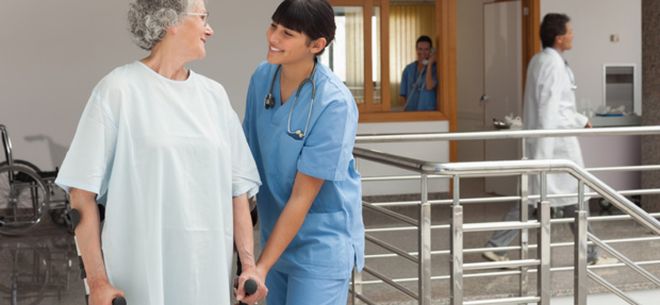
Each body is individual, and the brain of an individual person has its own characteristics, for this reason some patients require more or less time for recovery.
Exercises for recovery after a stroke
Doctors' forecasts make it possible to understand how long it will take to fully or partially restore vital functions. Rehabilitation should begin as soon as possible after the patient’s general condition has stabilized.
His relatives should actively participate in the treatment, monitor the implementation of the plan, taking into account changes, increase the load and set new goals for the patient.
- Paralysis of the upper and lower extremities, weakness in the legs or hands. More often, the patient is paralyzed in one part of the body, but he can get up, sit and even walk on his own. Elimination of the problem is achieved with the help of physiotherapeutic and drug treatment; after visible improvements occur, the patient will have to train and do exercises.
- Spasms and increased muscle tone. Often paralyzed limbs remain in one position for a long time, which provokes problems with mobility. Specialists prescribe special medications, muscle relaxants, and physical therapy.
- Speech problems. Partial or complete speech therapy speech impairment is observed in all patients who have suffered a stroke. Often such patients lose the ability to write; restoration of this function occurs under the supervision of a speech therapist.
- Difficulty swallowing. Dysphagia or difficulty swallowing food and liquids can cause pneumonia if food gets into the windpipe area. This occurs due to damage to the nerves that are involved in swallowing function.
- Vision problems. Often, after a stroke, patients have severe vision loss; its partial loss is due to impaired brain function.
- Disorders of the gastrointestinal tract and bladder. Urinary incontinence and constipation are the main problems for bedridden patients. Intestinal problems arise due to prolonged stay in bed; they can be eliminated after correcting the diet, training the pelvic muscles and increasing physical activity.
Another common complication is epilepsy and mental disorders. Stroke patients often experience depression, increased emotionality, anxiety, constant mood swings and an inability to control themselves.
Mental disorders can slow down the recovery process, so doctors often prescribe special sedative medications. During the period from 6 months to 2 years, some patients develop epilepsy, requiring separate treatment.
After returning to normal life, many patients want greater independence, for example, to start driving again, go to work and perform normal and everyday activities.
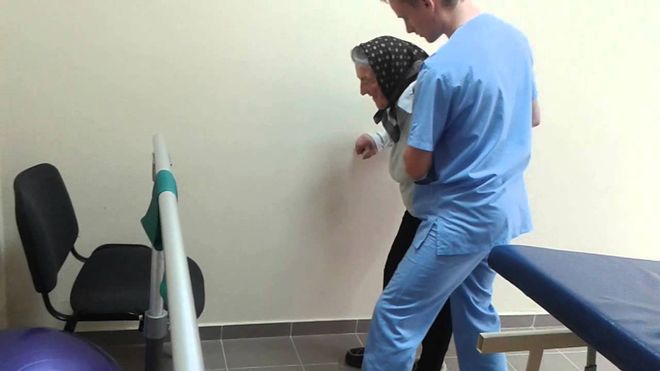
Unfortunately, a stroke imposes a number of restrictions on many types of activities; such prohibitions greatly complicate the patient’s life and negatively affect his emotional background.
When answering whether it is possible to play sports after a stroke, many doctors recommend including feasible and moderate exercise in the second recovery stage.
Sports and physical activity restore muscle tissue, help the patient learn to control his body again, and strengthen the functioning of the nervous system.
By maintaining optimal activity, the likelihood of recurrent strokes is significantly reduced. The first month of therapy is the most important after illness and includes many procedures.
Important! Intense fitness classes, visits to a standard sports center and swimming pool are prohibited in the first stages of recovery. The patient should not engage in strenuous sports.
Such exercises should be regular, only in this case they will bring real benefits. Swimming in the sea and swimming in the pool is prohibited for several months of the rehabilitation period.
Light exercise has a positive effect on the nervous system, develops the heart muscle, reduces excitability and increases the body's resistance to stress in both women and men.
Strong exercise has a positive effect on the respiratory system, increases lung capacity and allows the brain to receive more oxygen.
Many people are interested in whether it is possible to go to the bathhouse after a stroke, and how the steam room will affect the functioning of the brain and other body systems. Doctors allow visiting the bathhouse, but in each individual case the patient will need to undergo an examination, including an MRI, and receive additional consultation.
Due to the possible development of complications, water procedures can worsen the condition or lead to sudden death. During the first year after a stroke, going to the bathhouse is strictly prohibited.
If recovery proceeds as usual, brain damage is minor, and scarring of necrotic tissue occurs at a rapid pace, short visits to the steam room will do more good than harm.
If the patient takes a steam bath and goes to the sauna, observing all safety measures, he will notice the effect in a short time. The list of advantages of baths and saunas after a stroke includes vasodilation and relaxation of the musculoskeletal system, improved blood supply and intensive nutrition of nerve cells.
Bath after a stroke
The nutrition of patients is of great importance and directly affects recovery. Compliance with the diet recommended by the doctor will help to significantly shorten the rehabilitation period and improve the patient’s general condition.
The diet should include foods that reduce the formation of blood clots and thin the blood. It is recommended to eat lean meat and fish, more boiled or stewed vegetables, fresh fruits, berries and herbs, nuts, bee products, and healthy carbohydrates in the form of cereals.
When asked whether it is possible to drink black coffee after a stroke, doctors usually recommend giving up this drink for a while and giving preference to weak tea or herbal infusions.
The list of prohibited foods includes fatty meat and lard, high-fat dairy products, mayonnaise, smoked foods, spicy, fried and salty foods.
- exclusion of alcoholic beverages, coffee and tobacco, which negatively affect the process of restoration of brain cells and the functioning of the immune system;
- minimizing the consumption of sugar and salt, which have a bad effect on blood vessels and the circulatory system;
- exclusion of foods containing large amounts of cholesterol and transgenic fats;
- reducing the intake of dishes made from wheat flour.
